Orwell Astronomical Society (Ipswich)
Transit of Mercury, 11 November 2019
James Appleton and Martin Cook coordinated arrangements for observing the transit from Orwell Park Observatory. Following customary practice, they aimed to utilise the Tomline Refractor to project an image of the solar disk, which could be studied visually and photographed, leaving observers on the balconies of the Observatory to use more sophisticated electronic imaging in both white light and Hα wavelengths.
Preparations
Experience with previous transits [a] demonstrated the benefit of an effective sunshade in minimising ambient sunlight entering the dome, thereby improving the contrast of the projected image. On 11 November, the Sun would attain a maximum altitude of only approximately 20° so the sunshade needed to accommodate only a modest elevation of the telescope. James designed a sunshade utilising the runners introduced for the 2016 transit, using a double thickness of semi-opaque plastic flooring material fixed in position to obscure the bulk of the aperture, with a flexible fabric covering the lower portion, able to ride up and down the runners to accommodate the movement of the telescope.
Experience with the 2016 transit indicated that sunshade construction and installation could be an elongated affair, so work in 2019 began in good time. James finalised the design and purchased materials in mid-late October. Due to supply problems, he used canvass for the lower, movable part of the sunshade, and attached wooden battens which in turn would attach to runners able to move up and down the rails. Members of OASI assembled scaffolding in the dome on 30 October and began the task of assembling the fixed element of the sunshade. Unfortunately, it immediately became apparent that the plastic material would be too flimsy to withstand the rigours of a strong wind (should there be one), and an alternative design was required; the decision was quickly made to replace the plastic with a length of blackout fabric. James and Martin completed assembly of the sunshade on 10 November, and also fitted a 1 m square lightshield at the OG end of the Tomline Refractor and obscured the windows of the dome. The result was a dark interior, with relatively little ingress of ambient light. See figures 1-8.
Arrival At Orwell Park On 11 November
On the day of the transit, observers assembled at the School at 10.00am [c], and made their way to the Observatory by 10.15am. On arrival, the weather was most unpromising, with wind, cloud and occasional rain. No-one among the party had any expectation of seeing even the Sun, let alone planet Mercury! The weather had dissuaded several would-be observers from attending.
More in hope than expectation, James and Martin mounted the camera bracket on the Tomline Refractor and attached a Canon 1100D and a Canon 6D Mk II (figure 9). They then rejoined the remainder of the group in the Belvedere and all gloomily surveyed the weather. At 11.00am, all staff and pupils from the School trooped onto the grass at the rear of the premises and held a ceremony marking Armistice Day. Those present in the Observatory looked on from a balcony, and marked the two minute silence, ended by a bugler.
By 11.30am, although there had been brief periods during which small areas of thinner cloud enabled the Sun to be glimpsed, the outlook for the transit remained hopeless. However, during the next 30 minutes, the rain ceased and the cloud gradually thinned, and it became apparent that there might be a chance to observe after all! A frantic effort then ensued to open the dome, mate the Tomline Refractor to the sunshade with the OG protruding through to the sunlit side (figure 10), align on the Sun and begin observing.
The sunshade proved so effective that the telescope did not cast any appreciable shadow, and aligning it on the Sun therefore proved tricky. Martin eventually succeeded in the alignment and the telescope drive was engaged to track the apparent motion of the Sun. The observers selected a large, ex-military surplus eyepiece (the same one employed for observation of previous transits). This projected an image of the Sun approximately 75 cm in diameter. The image was too large to fit in total on the projection screen, so the telescope was adjusted to centralise the portion of the solar limb where Mercury would first appear (figure 11) [d]. By 12.21pm, everything was in place and the two cameras were recording videos of the projected image. Martin secured a large radio-synchronised "Rugby" clock (more properly an MSF clock) to the corner of the projection screen for timing events.
Due to the low altitude of the Sun (approximately 19°), the image was very unsteady, and the solar limb in particular suffered continuous undulations. The low altitude of the Sun also meant that the contrast of the image was not as great as at previous transits. No sunspots could be seen. The observers thought at one stage that some solar granulation was visible but, on close inspection, this conclusions was very uncertain. Cloud could be seen crossing the image from time to time, causing varying degrees of obscuration (figure 12).
Ingress Phase
At 12.30pm, just before first contact, with Martin downstairs in the Belvedere, James adjusted the position of the sunshade and, unfortunately, because of its coupling to the telescope, the position of the latter also changed, slewing away from the Sun. Fortunately, Martin shortly returned to the dome and was able to reposition the telescope and, by 12:33:30 UT, with only two minutes until first contact, observations resumed. Phew – that was close!
Paul Whiting joined James and Martin to observe ingress. The observers called first contact at 12:35:47 UT. At approximately 12:36:49 UT, the black drop effect began. It ended, with the planet appearing fully inside the solar disk, at 12:37:11 UT. Shortly thereafter, the difference in size between the Sun and the silhouette of the planet became very pronounced, the latter appearing only approximately 4 mm in diameter.
Later frame-by-frame analysis of the video from James' camera provided slightly different estimates of event times. Table 1 compares the event times predicted by theory (assuming geometric contact times), recorded in the dome, and estimated by offline analysis of the video. The black drop effect, unsteadiness of the image and the small apparent size of the silhouette of Mercury conspired to make the estimates of event times very uncertain. Predicted times are calculated with the NASA JPL ephemeris DE-430.
| Event times | |||
| Event | Dome | Video | Theory |
| 1st contact | 12:35:47 | 12:35:39 | 12:35:35 |
| Start of black drop | 12:36:49 | 12:36:45 | - |
| 2nd contact | 12:37:11 | 12:37:07 | 12:37:16 |
| End of black drop | Uncertain | 12:37:16 | - |
Table 1. Event times (UT).
Figure 13 shows still images taken by Martin, using a Samsung S7 mobile phone, which illustrate well the black drop effect and the unsteadiness of the limb.
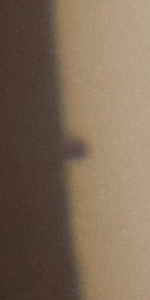
12:37:09
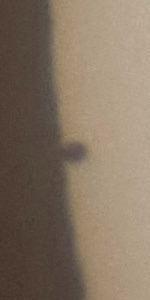
12:37:10
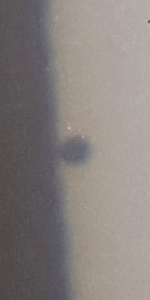
12:37:18
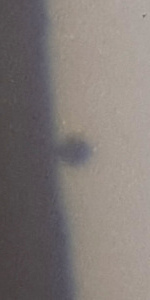
12:37:19
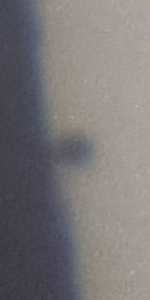
12:37:22
Fig. 13. The black drop and limb unsteadiness.
Figure 14 is a montage of the images from the 6D Mk II during a two-minute period starting at 12:35:35 (the predicted time of 1st contact).

12:35:35

12:35:36

12:35:37

12:35:38

12:35:39

12:35:40

12:35:41

12:35:42

12:35:43

12:35:44

12:35:45

12:35:46

12:35:47

12:35:48

12:35:49

12:35:50

12:35:51

12:35:52

12:35:53

12:35:54

12:35:55

12:35:56

12:35:57

12:35:58

12:35:59

12:36:00

12:36:01

12:36:02

12:36:03

12:36:04

12:36:05

12:36:06

12:36:07

12:36:08

12:36:09

12:36:10

12:36:11

12:36:12

12:36:13

12:36:14

12:36:15

12:36:16

12:36:17

12:36:18

12:36:19

12:36:20

12:36:21

12:36:22

12:36:23

12:36:24

12:36:25

12:36:26

12:36:27

12:36:28

12:36:29

12:36:30

12:36:31

12:36:32

12:36:33

12:36:34

12:36:35

12:36:36

12:36:37

12:36:38

12:36:39

12:36:40

12:36:41

12:36:42

12:36:43

12:36:44

12:36:45

12:36:46

12:36:47

12:36:48

12:36:49

12:36:50

12:36:51

12:36:52

12:36:53

12:36:54

12:36:55

12:36:56

12:36:57

12:36:58

12:36:59

12:37:00

12:37:01

12:37:02

12:37:03

12:37:04

12:37:05

12:37:06

12:37:07

12:37:08

12:37:09

12:37:10

12:37:11

12:37:12

12:37:13

12:37:14

12:37:15

12:37:16

12:37:17

12:37:18

12:37:19

12:37:20

12:37:21

12:37:22

12:37:23

12:37:24

12:37:25

12:37:26

12:37:27

12:37:28

12:37:29

12:37:30

12:37:31

12:37:32

12:37:33

12:37:34
Fig. 14. Images taken approximately every second during ingress.
Mid-Transit
After the excitement of the ingress phase, Mercury continued its serene passage across the solar disk. Figure 15, by Andy Gibbs, shows a typical view taken mid-transit.
Parties of school children began arriving at 12.45pm to see the transit. Some pupils asked very insightful questions, among them:
While the children were visiting, two spectacular silhouettes of aeroplanes were visible transiting the Sun’s disk (at 2.35pm and 2.50pm). They appeared large, in focus, and travelled fast. The children were impressed!
The weather deteriorated during early afternoon and the Sun was increasingly obscured by clouds. At 3.10pm, the last party of schoolchildren left the dome and the observers packed up.
Andy Gibbs, Paul Whiting and Mike O'Mahoney observed mainly from the balconies at Orwell Park, using a Celestron Nexstar 8SE (figure 16) and Coronado PST (figure 17). They spotted Mercury first in the Celestron. They were unable to give an accurate estimate of the time of 1st contact, but noted that it was within a minute of the predicted time. Mercury was more difficult to spot with the PST, until it had moved fully on to the solar disk, when it became easily visible.
During periods when the sky became too cloudy for observations, Paul entertained the visiting pupils with talks.
Observers attending Orwell Park at various times throughout the day were: Roy Adams, Merlyn Adams, James Appleton, Bill Barton, FRAS, Martin Cook, Andy Gibbs, Caroline Newman, Mike O’Mahony, Paul Whiting, FRAS.
I had originally intended to use the same equipment I used for the 2016 transit. However, a lack of time meant that I instead relied on a poor quality refracting telescope fitted to a newly acquired Skywatcher motor-driven mount. If I had been better prepared, I would have constructed an adapter to enable the telephoto lens arrangement used in 2016 to be fitted to the Skywatcher mount. Next time, perhaps! I used the following equipment for observation and imaging:
Owing to winds gusting to 30 mph, I had to observe from inside the lounge (with the patio door open). Thick, fast-moving cloud and occasional showers prevented me from focussing the telescope until just a few minutes before 1st contact. I was unable to achieve focus over the complete disc of the Sun, owing to some sort of problem with the telescope optics and wind shake (even indoors!)
It being daytime, there was no opportunity to execute the three-star alignment procedure required by the mount for accurate tracking. I therefore used the camera in live view mode to monitor the image, enabling me to keep the tracking under manual adjustment. However, there was much cloud causing periods of up to several minutes when I could not see the Sun to maintain tracking. Nevertheless, I started imaging at around 12:14, capturing occasional exposures between thick clouds. During the ingress phase, from 12:30 to 12:48, I saved an image every few seconds (using ad-hoc timing). I was not able to estimate the times of 1st and 2nd contact.
A sample of my images is below:
The weather didn't promise much for seeing the transit. About midday it brightened up, but remained somewhat windy. Setting the exposure was problematic with clouds scooting by, causing the image to be either black or burnt out, and the lack of anything to focus on (no sunspots), other than the limb of the Sun, made setting-up quite difficult. In the end Mercury itself was the focus aid. After capturing some images, the Sun slid behind a neighbour's rather bushy tree.
The skies cleared for a while, but then clouds came and went periodically, then a large cloud bank appeared. By the time this passed, the Sun was vanishing into yet more foliage and I called it a day.
The below animation does at least show that I was not recording a sunspot or a piece of dirt in the camera!
Figure 24 is a still taken from the video, a mosaic of images showing the motion of Mercury in mid-transit.
The morning of 11 November started out wet and overcast. However, around 12:30 UT the sky started to brighten and, some 20 minutes later, there were several clear patches. I got out my 70 mm Maksutov telescope for solar projection. The sky looked very "milky" and the projected image was much fainter then usual, probably due to a thin layer of cloud. Unfortunately, I could not see the silhouette of Mercury. I then used my solar binoculars to look for the silhouette, again without success. I temporarily abandoned observations around 12.55 UT.
I resumed observations around 14:45 UT. This time I used my 90 mm Maksutov, fitted with a white light solar filter, set up in the front garden. I continued observing until the Sun disappeared behind nearby houses, at about 15:45 UT. During the hour when I observed, there were a few fleeting gaps in the clouds, and I saw Mercury for a minute or two, totalled over four or five clear patches.
Equipment: Helios 114 mm Newtonian, focal length 910 mm, on EQ1 mount. 20 mm eyepiece. It was very windy so the telescope wobbled about a lot on its rather flimsy mount. Mainly cloudy with occasional patches where full sunlight shone through during which I visually observed the tiny black disc of Mercury for several minutes total time. No sunspots were visible. I attempted several photographs with an iPhone 5 camera held up to the eyepiece, and then with a compact camera on a mount clamped to the eyepiece. Due to difficulties focusing, and telescope wobble, only one photo showed Mercury - along with a lot of crud on various lenses!
The photo is shown in figure 25. Taken at 13:50 UT with an iPhone 5. In the thumbnail, an arrow points towards Mercury.
I couldn't observe the transit from home due to trees obscuring the view. (Of course, the rain, wind and cloud didn't help either!) So instead, I downloaded images from the SOHO (Solar and Heliospheric Observatory) satellite and assembled them to form figure 26. The figure is a composite of slices of MDI Continuum images taken every 1.5 hours, starting at 12:00 UT, approximately 35 minutes before 1st contact. (MDI is the Michelson Doppler Imager, an instrument on SOHO which studies the interior of the Sun by measuring oscillations in the appearance of the photosphere.)
I observed the transit using a Dobsonian-mounted 200 mm Newtonian fitted with Baader solar filter, but with intermittent cloud and obscuration by a neighbour's trees. No successful image captured.
All there was to see from Geneva all day was an unbroken layer of cloud...
[a]
Transits which OASI observed or attempted to observe in the early years of the 21st Century are: transit of Mercury, 07 May 2003, transit of Venus, 08 June 2004, transit of Venus, 06 June 2012 and transit of Mercury, 09 May 2016.
[b]
Image credits are as follows: JMA=James Appleton, MPC=Martin Cook, AG=Andy Gibbs, ANM=Neil Morley. Other images are credited in the text.
[c]
All times in this article are expressed as UT.
[d]
All images above are shown in approximately naked-eye orientation; this has necessitated some being rotated/flipped.
[1]
J. Meeus & A. Vitagliano, "Simultaneous Transits", Journal of the British Astronomical Association, vol. 4, no. 3, pp.132-135, 2004.
Compiled by James Appleton